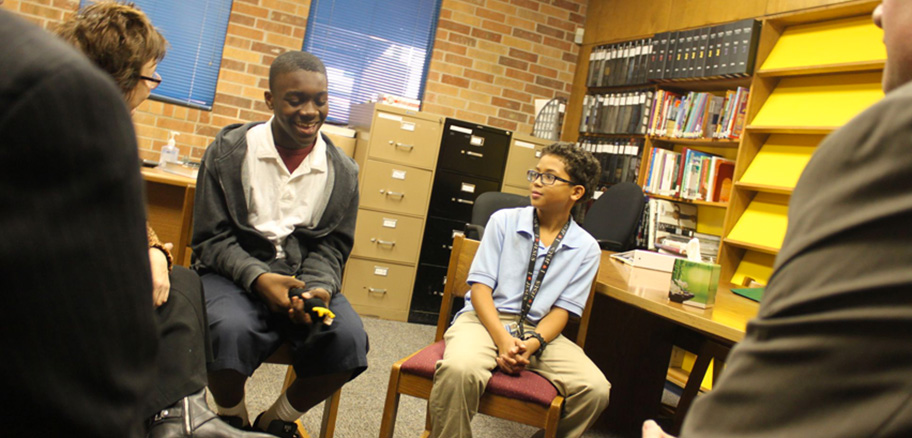
Let’s Circle It
How one school could change the state’s discipline landscape
Over the past 18 months, the saying “circle it” has become part of the vernacular for students at Edward H. White Middle School.
Born from a social experiment to change how the school metes out punishment, “circling it” refers to how the students and educators sit in a circle and talk to each other as a way of tackling conflict or disciplinary issues instead of immediately opting for an out–of–school suspension or expulsion. The term illustrates the progress made at the North East Independent School District campus since the start of a unique collaboration with The University of Texas at San Antonio and The University of Texas at Austin.
What’s happening is actually a form of restorative discipline–something that hasn’t been tried at this level anywhere in Texas.
“We’ve gotten an unbelievably positive response from students,” Ed White Principal Philip Carney said. “It’s given them a voice. They were coming to us and saying, ‘we have conflict over here and if we don’t work it out, it’s not going to be good.’”
The proactive approach addresses conflict or disruptive behavior by bringing together those involved, talking about the issue and finding a solution. The hope is that by engaging students, they will be more responsive and responsible for their own actions. And in turn, off–task behavior will subside.
Outsiders are watching the process closely at Ed White, and Carney said he has fielded interest from other administrators. The changes there could end up providing a roadmap of sorts for other schools in the state or even nationwide.
“What I saw was we needed to do something differently,” Carney said. “What we were doing wasn’t working to get us to being a successful campus.”
Carney decided to look into restorative methods after his wife, who was then a UTSA criminal justice student, told him about the restorative justice class taught by Robert Rico, a retired police officer and lecturer. Carney reached out to Rico, who in turn sought out Marilyn Armour, a UT Austin professor and head of the Institute for Restorative Justice and Restorative Dialogue, or IRJRD.
In fall 2012, the middle school embarked on a three–year implementation process to move from a traditional punitive approach to something more flexible.
Rico, who helped monitor the implementation’s first year, said that traditional, zero–tolerance policies that result in high expulsion and suspension rates help feed at–risk students into what has been dubbed the school–to–prison pipeline.
A disproportionate number of those affected by these disciplinary policies are minority and low–income students.
“There is a correlation to when [students] get expelled they are more likely to be involved with the juvenile justice system,” Rico said. “So that’s the cycle we’re trying to break.”
The IRJRD is compiling information from each of the three years of the new program, and has released a report on the initial implementation.
When the process began at Ed White, approximately 82 percent of the 985 students were economically disadvantaged, according to the IRJRD’s year–end report. Fifty-three percent of students of that class were Hispanic and 30 percent African–American. Student performance was well below the state average in passing state standardized tests, the report said.
In the first year of implementation, more students who may have been subject to suspensions were kept in class and off–campus suspensions decreased by 84 percent. There were fewer physical altercations between the students involved as well, Rico said.
“The kids were turning to circles rather than ending up in a situation where all they can do is fight,” Armour said. “For the kids it really became another option.”
The students were the ones who created the “circle it” form, which is filled out and taken to a teacher or administrator to request a circle.
Circles can involve a whole class, or just a student and teacher or administrators, to name a few examples. The students are encouraged to be truthful about why they might be acting out, falling asleep in class, stealing food, bullying or threatening classmates, or just being disruptive.
The first year began with just the sixth–graders, and over the course of the three years, another grade level will be added until all teachers are trained to use the methods.
The results showed the opening year was “pretty messy,” Armour said. Restorative discipline is more time–consuming and requires serious commitment from teachers and administrators.
For teachers the results were mixed. Some took to the idea more than others. There were concerns about a lack of support from administrators in terms of guidance on implementation processes, not enough training and the possibility that students were initially using circles as a way to escape a more serious punishment.
“It’s a philosophy,” Rico said. “There’s not a manual that says how you do it.”
Several teachers described a less stressful atmosphere after using the circles to talk to students about concerns. One teacher documented how the circle helped her level with her class about standardized testing.
“She really pulled them in, in a partnered way, and used the relationship to say ‘we’re really in trouble, and we need to think of some way collectively to move this forward,’” Armour said. “And it’s not necessarily that everyone did great, but she didn’t come away from it frustrated and despairing.”
The evaluations and teacher feedback will be used to make changes or address concerns.
Even if there are bumps in the road, Carney, himself a UTSA graduate in 1999, said the collaboration with the two universities has given his school an opportunity rarely afforded to other schools: to take on an ambitious examination of discipline school–wide in the hope of better serving the staff and students.
“We can say all day long that all the students should just show up, sit down, and learn but that’s not reality, it’s not that simple,” Carney added. “We need to work in reality and live in reality and teach in reality.”
–Michelle Mondo
Web Extra: To view the report, go to utexas.edu/research/cswr/rji

